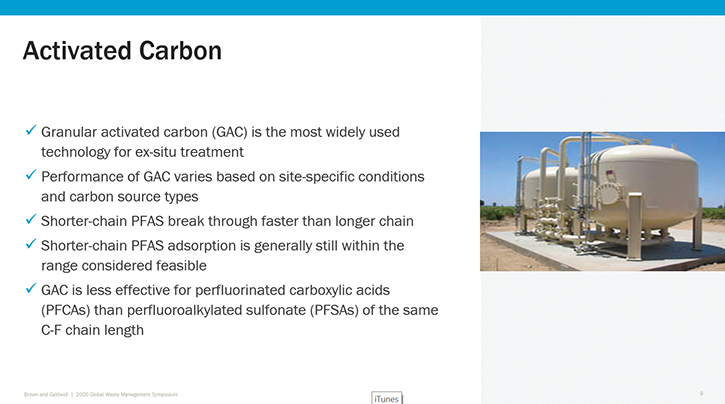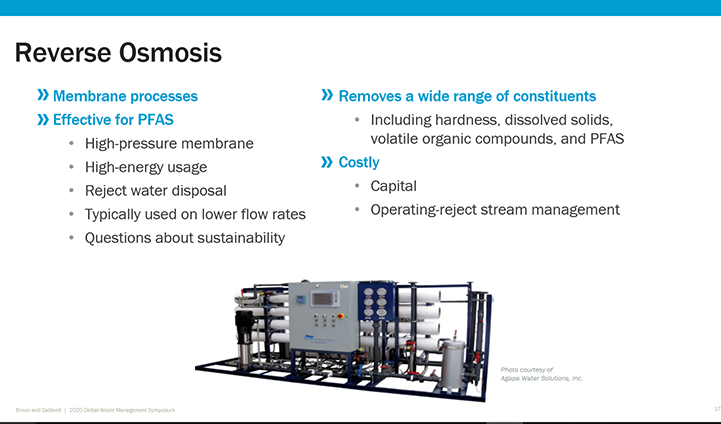Testing Emerging PFAS Treatment Technologies
During GWMS 2020, experts discussed some of the most widely used and tested PFAS remediation technologies.

As regulatory drivers develop to manage and remediate per- and polyfluoroalkyl substances (PFAS) contamination, emerging technologies to treat these “forever chemicals” are being tested on both a national and global scale.
Earlier this week, the U.S. Environmental Protection Agency (EPA) released an updated PFAS Action Plan. According to EPA, aggressively addressing PFAS is an “active and ongoing priority” for the agency. One year ago, the agency announced its PFAS Action Plan—the agency’s first multimedia, multi-program, national communication and research plan to address an emerging environmental challenge like PFAS. EPA noted that it continues to make progress implementing this plan, including proposed regulatory determinations for perfluorooctanesulfonic acid and perfluorooctanoic acid in drinking water.
During a Global Waste Management Symposium (GWMS) 2020 session on PFAS treatment technologies, Jeffrey Pintenich, remediation and water PFAS lead for Brown and Caldwell, explained that although PFAS compounds won’t disappear from the environment, they will transform in a biological wastewater treatment plant.
As they continue to emerge, PFAS treatment technologies have been broken down into the following three rankings:
Field implemented technologies—Demonstrated under full-scale conditions at multiple sites, by multiple practitioners and applications, and are well-documented in peer-reviewed literature.
Limited application technologies—Implemented on a limited number of sites, by a limited number of practitioners, and may not have been documented in peer-reviewed literature.
Developing technologies—Researched at the laboratory or bench scaled, but these technologies have not been field demonstrated.
When it comes to water treatment, effective conventional approaches, with limitations, include carbon adsorption, resin adsorption and reverse osmosis. Carbon adsorption and resin adsorption have been most commonly applied. Typically, ineffective conventional technologies include air stripping and air sparging. And technologies in development include bioremediation, chemical oxidation, chemical reduction and others.
For developing technologies like chemical oxidation and reduction, Pintenich explained that “people are working on this furiously” across the world. He pointed to more peer-reviewed research coming out of Southeast Asia than in North America.
Adsorption and Emerging Technologies
Granular activated carbon (GAC) is the most widely used technology for ex-situ treatment of PFAS. GAC typically is “reactivated” under high temperature and reused, as less aggressive “regeneration” methods are not appropriate for PFAS, noted Pintenich.

Additionally, GAC performance varies based on site-specific conditions and carbon source types.
Reverse osmosis (RO) uses high-pressure membrane processes that are effective for treating PFAS, explained Pintenich. Although RO removes a wide range of constituents—PFAS, dissolved solids and volatile organic compounds—it can be costly.
“There are a lot of technologies with a promise to treat PFAS. There are only a few that are considered field implemented—pump and treat with GAC, membrane filtration or ion exchange (IX),” he added.
Ivan Cooper, wastewater and water practice lead for Civil & Environmental Consultants and chairman of the Solid Waste Association of North America’s Leachate Committee, highlighted additional emerging technologies.

As part of that committee, Cooper and his team are preparing what he referred to as “PFAS Wiki,” a site specific to PFAS for the solid waste industry.
When it comes to treating PFAS, Cooper explained that GAC works well for the longer chain of PFAS but not as good for some of the shorter-chain compounds. He added that IX typically requires some pretreatment and is better for treating larger-chain carbons over smaller-chain compounds.
He also mentioned reverse osmosis, as well as deep well injection, which can be a long and expensive process to permit a site. “There are some sites that we’ve had for five years in the permitting process. It depends on the area around it and what the formation is—geology, receptors, seismicity,” he said. “You have to do some pretreatment. It is also expensive in terms of the energy you need to inject leachate down to a formation.”

Cooper pointed to an emerging technology being tested in Australia and the UK that extracts out groundwater in the ozone treatment until it forms a foam. The technology is being tested in liquid waste treatment, but it has not yet been tested on leachate.
Chemical oxidation is another emerging technology that involves elevating temperatures to destroy PFAS constituents. So far, it works better on longer-chain compounds and has not been tested on leachate. The technology has, however, been laboratory and field tested in contaminated groundwater.
EPA said in its updated plan that it also has numerous PFAS treatment and disposal research projects underway, including on high-temperature incineration and other methods. The agency said it is collaborating with other federal partners, including the Department of Defense, on efforts to increase the agency’s understanding and availability of treatment technologies for PFAS, including analytical methods.
About the Author
You May Also Like




.png?width=300&auto=webp&quality=80&disable=upscale)